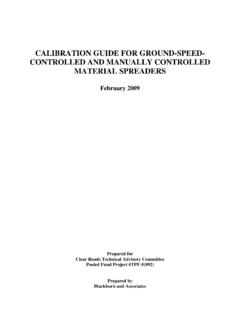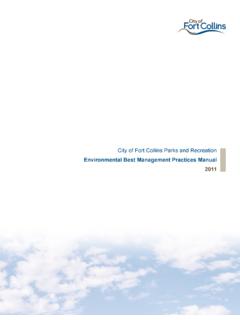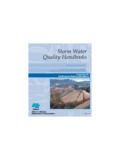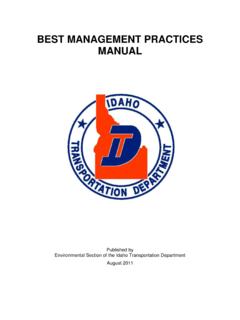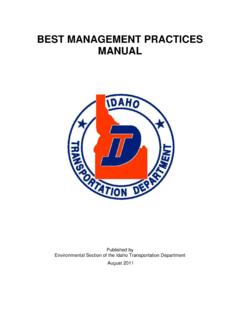Transcription of Manual of Best Management Practices - Clear Roads
1 Manual of best Management Practices for Road Salt in Winter Maintenance TABLE OF CONTENTS. Introduction Pg #3. Procurement Adequate Storage Pg #4. Emergency Stockpile Capability Pg #6. Tightly Specified Quantities in Bid Documents Pg #8. Multi-Year Contracts Pg #10. Pre-Season Fills of Stockpiles Pg #12. Storage Adequate Storage And Environmentally Safe Storage Facilities Pg #14. Optimal Facility Layout Pg #16. Shared Facilities Pg #18. Optimizing Facility Operations and Novel Ideas Pg #20. Applications Pre-wetting Pg #22. Anti-icing Pg #24. Variable application rates Pg #26. Equipment calibration Pg #28. Measurement Pg #30. Accountability Pg #32. Liquid Usage Pg #34. Cold Temperatures Pg #36.
2 Forecasts Pg #38. Service Levels Pg #40. Training Pg #42. FEMA-EMAC. Emergency Management Assistance Compact (EMAC) Pg #44. Federal Emergency Management Agency (FEMA) Pg #45. About the Authors Pg #47. 2. INTRODUCTION. The purpose of this handbook it to present best Management Practices (BMP) for road salt in winter maintenance in a format that is easy to use and access. While it is understood that individual agency experience may vary, this compilation represents the best Practices as determined by a wide group of State and local agencies. The handbook contains two pages for each of the BMPs (with one exception) so that if agencies wish they can print off the two pages for a given BMP. and post them or perhaps laminate them to place them in a break room for discussion.
3 We have done this because the primary challenge with BMPs is implementation. The science behind the BMPs in this document is well known, and the benefits of implementing them have been proven for many years. Yet, they are still not as widely implemented in winter maintenance operations in the US as they should be. Many reports have been written to support the Practices described herein but the challenge with such reports is that they often end up on a shelf, unread, unremembered, and most importantly (and disappointingly) unimplemented. Hence this rather unscientific format for the handbook! All the supporting information for the BMPs in the handbook are given in the project report, which is available from Clear Roads ( ).
4 The goal of this handbook is to avoid the shelf fate of a report, and to survive in the environment where it can perhaps do the most good (which would include the break room). Each agency has its own way of making change. The handbook does not necessarily address implementation (although each BMP includes a few words on the needs associated with implementing that BMP) but does provide a starting point for the implementation. We hope that you find it useful. 3. PROCUREMENT. According to the Salt Institute's Salt Storage Handbook, an agency should have at least 100%. of a normal year's supply stored for its winter operations. As this relates to the bidding process, adequate storage is vital for any agency to ensure it will have enough material for a normal winter season.
5 Agencies that have less than 100% of their yearly supply stored onsite will depend on the vendor to store their needed material and be able to deliver that BIDDING AND material throughout the winter season. This is critical PROCUREMENT BMP: because many factors can hamper the delivery of the material and the Adequate Storage agency assumes a great deal of risk. Demand for delivery is greatest during the winter season and this is normally when delivery conditions are at their worst. Contracts require that salt be delivered in a timely manner to all agencies so vendors must meet these demands. This means agencies compete with one another to resupply their stockpiles. Delivery from mines can also be affected during the season should waterways become impassable.
6 Most salt is moved by barge or ship before being distributed locally by truck. A variety of weather conditions can hamper movement of waterway traffic but frozen waterways virtually cease any deliveries. 4. PROCUREMENT. Agencies that can store POTENTIAL IMPACT. 100% of their seasonal needs PRACTICE IN SALT PROCUREMENT. OF PRACTICE. should have the salt in place prior to the beginning of the Having storage for 100% to 150% of Lowers costs winter season. Agencies that average annual salt needs (AASN). do not have it in place are subject to the same delivery Having emergency stockpile for Lowers costs 20% to 40% of AASN. issues stated above. Agencies that have multiple sites need Specifying desired salt quantities to consider if the storage they Lowers costs as tightly as possible have is adequate for the area it serves.
7 Having 100% of your Requiring mid-winter delivery in short time period Raises costs salt stored is vital, but it also must be in the appropriate Allowing salt deliveries at any given time area. A number of agencies Lowers costs (rather than during work hours). made the point that even if a state has storage statewide Requesting bids earlier in the year Lowers costs for more than 100% of their average annual salt needs that does not mean that the Having multi-year contracts Lowers costs salt will be in the correct part of the state. Taking pre-season fills of salt Lowers costs Having 100% of your seasonal needs means you will have enough material in a normal THE NUMBERS: Agencies with adequate storage are less likely to winter.
8 Depending on the face shortages, less likely to be impacted by delivery issues and contract some agencies may less likely to encounter higher costs. purchase additional material but this may be subject to THE ALTERNATIVES: Implement a long term plan to increase higher prices. In times of salt storage. Consider shared facilities with other agencies. Consider vendor holding reserves for your agency. shortages price can be less of a factor than availability but THE NEEDS: With many changes in the types of storage facilities higher prices are inevitable more storage may be possible at reasonable costs. Additionally, because salt must come many facilities have met their useful life and when replacing them from less traditional sources today's needs may be addressed in additional storage and proper and shipping costs increase.
9 Placement. Consider adding conveyor systems to maximize the full Agencies that store 150% or potential of any facility's capacity. more of their yearly needs THE FUTURE: More regional storage opportunities are being rarely run out even in extreme planned. Many States have plans to increase storage. winters. For those agencies, mid-winter deliveries will only be required during extremely severe winters, although A best practice is agencies having storage for 150% of their as a matter of practice average annual salt usage, appropriately placed throughout many agencies will take salt their region of operations. The greater the storage capacity deliveries during the winter that an agency has, the less their salt costs will be impacted season to maintain their by changes in demand for salt, especially after high salt usage.
10 Stockpile readiness. 5. PROCUREMENT. According to the Salt Institute's Salt Storage Handbook, an agency should have at least 100% of a normal year's supply stored for its winter operations. A. few states and some local agencies have in place emergency stockpiles of salt to supplement their annual seasonal supplies. These emergency stockpiles are for situations during severe winter events and when salt supplies become extremely low and resupply has become BIDDING AND difficult or impossible. PROCUREMENT BMP: Some of these emergency supplies are uniquely stored Emergency underground. The remaining emergency supplies are stored traditionally but Stockpile Capability generally in remote locations and are only used when the normal operating supplies run very low.
